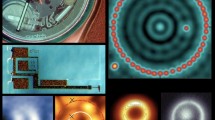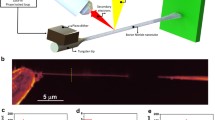Abstract
Dielectrophoresis (DEP) force is a widely studied topic because it has high utility in various research areas. Understanding DEP force is significant from the point of view of its efficient usage. Here, we confirmed the directions and magnitudes of DEP forces for metallic and non-metallic particle manipulations as well as force measurements via a quartz tuning fork atomic force microscopy (QTF-AFM) system. The 100 nm non-metallic silica particles having negative DEP force move toward the minimum point of the square of the electric field while the 60 nm metallic Au particles have positive DEP force. We also measured the magnitude of the DEP force in a liquid environment with electrodes. The experimentally measured DEP force magnitude was about 1 nN, which was similar to the simulation results, and the tendency of the measured force was consistent with that of the simulated case. This shows the possibility of using a QTF-AFM system as the fine force sensor in a liquid environment.
Similar content being viewed by others
References
H. A. Pohl, J. Appl. Phys. 22, 7 (1951).
H. A. Pohl, J. Appl. Phys. 29, 8 (1958).
H. A. Pohl, Dielectrophoresis: The behavior of neutral matter in nonuniform electric fields (Cambridge University Press, 1978).
K. Kaler and T. Jones, Biophys. J. 57, 2 (1990).
T. B. Jones, Electromechanics of Particles (Cambridge University Press, 2005).
M. Hywel and G. Green Nicolas, AC Electrokinetics: Colloids and Nanoparticles (Research Studies Press Ltd, 2003).
P. Tathireddy, Y-H. Choi and M. Skliar, J. Electrostat. 66, 11 (2008).
B. J. Kirby, Micro-and Nanoscale Fluid Mechanics: Transport in Microfluidic Devices (Cambridge university press, 2010).
R. Pethig, Biomicrofluidics 4, 2 (2010).
J. Tang et al., Nano Lett. 5, 1 (2005).
A. Slattery et al., Nanomaterials 7, 11 (2017).
M. Lee et al., Appl. Phys. Lett. 91, 2 (2007).
M. Lee and W. Jhe, Phys. Rev. Lett. 97, 3 (2006).
S. An et al., Rev. Sci. Instrum. 83, 11 (2012).
M. Lee et al., Faraday Discuss. 141, 415 (2009).
F. J. Giessibl, Rev. Mod. Phys. 75, 3 (2003).
S. An et al., Rev. Sci. Instrum. 85, 3 (2014).
M. P. Hughes, Nanoelectromechanics in Engineering and Biology (CRC press, 2002).
H. C. Chang and L. Y. Yeo, Electrokinetically Driven Microfluidics and Nanofluidics (Cambridge university press, 2010).
P. R. Gascoyne and J. Vykoukal, Electrophoresis 23, 13 (2002).
N.G. Green and H. Morgan, J. Phys. Chem. B 103, 1 (1999).
T. Honegger et al., Appl. Phys. Lett. 98, 18 (2011).
K. Park, S. Kabiri and S. Sonkusale, Biomed. Microdevices 18, 1 (2016).
A. Kosterev et al., Appl. Phys. B 100, 1 (2010).
M. Lee et al., J. Appl. Phys. 120, 7 (2016).
S. Kim et al., Appl. Phys. Lett. 86, 15 (2005).
B. Kim et al., Proceedings of the National Academy of Sciences (2015), Vol. 112, p. 51.
J. Kim et al., Ultramicroscopy 141, 56 (2014).
A.D. Slattery, J.S. Quinton, C.T. Gibson, Nanotechnology 23, 28 (2012).
T. R. Albrecht, P. Grütter, D. Horne and D. Rugar, J. Appl. Phys. 69, 2 (1991).
R. S. Lakes et al., Nature 410, 565 (2001).
M. Lee et al., Phys. Chem. Chem. Phys. 18, 39 (2016).
N. G. Green et al., J. Phys. D Appl. Phys. 31, 7 (1998).
F. Du et al., J. Electrostat. 65, 452 (2007).
Z. Liu et al., J. Opt. Soc. Am. B 33, 9 (2016).
Acknowledgments
This work was supported by the National Research Foundation of Korea (NRF) grant funded by the Korea government (MSIP) (2016R1A3B1908660) and (MEST) (2017R1A6A3A11033301), and in part by the Seoul National University Research Institute of Advanced materials and inter-university Semiconductor Research Center.
Author information
Authors and Affiliations
Corresponding author
Rights and permissions
About this article
Cite this article
Hong, S., Kim, C., Song, H. et al. Measuring Dielectrophoresis Force for Metallic and Non-metallic Particle Manipulations via a Quartz Tuning Fork Atomic Force Microscope. J. Korean Phys. Soc. 75, 1021–1027 (2019). https://doi.org/10.3938/jkps.75.1021
Received:
Revised:
Accepted:
Published:
Issue Date:
DOI: https://doi.org/10.3938/jkps.75.1021




